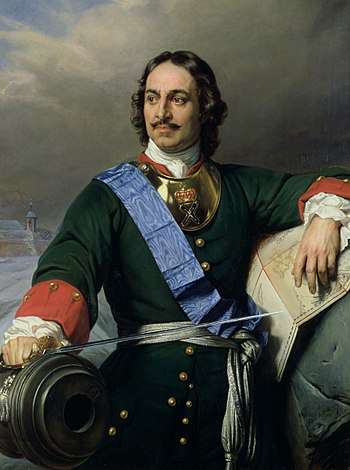Peter the Great

Peter the Great (1672-1725, reigned 1682-1725) was the Russian tsar who had enough of Russia being a conservative Eastern realm, and decided to make it a European power.
He ascended the throne of Russia as a co-regent to his weak and retarded brother Ivan V. After winning a battle for political dominance with his sister Sophia, he triumphed as the undisputed leader of Russia. Then he left the country and travelled to the West to learn its science and technology, and returned as an accomplished ship-builder.
After winning some wars with Turkey and Sweden, Peter the Great annexed lands neighboring two seas, the Azov Sea and the Baltic Sea. Then he founded St.Petersburg, an European-inspired city that was meant to be a capital of the future Russian Empire.
Peter's reforms after that meant basically gradual dismantling of the old Muscovite Tsardom and the creation of a new state, the Russian Empire. He introduced a new legal mechanism, the Table of Ranks, that provided a chance for talented and lucky commoners to make it into nobility, created many new noble bloodlines and conducted many other reforms.
Eventually, his claim of imperial status was recognized by foreign powers, and Russia officially became an empire in 1721. He died of cold after rescuing a soldier from one of early St.Petersburg many deluges caused by tidal activity and unpredictable winds. The Russian Empire founded by him was one of the world's superpowers until Red October, and he was a cult figure in Russia until the late XIX century, when the more conservative Muscovite-esque political ideas reached dominance.
Had a dysfunctional relationship with his son Alexei.
- Alternate Character Interpretation: Father of the nation or a crony of the evil Westerners who destroyed everything Russian? This argument started back in the nineteenth century and is still going on, though the first interpretation is much more common.
- Badass: He was fond of leading military campaigns from the front.
- Crazy Awesome
- Emperor Scientist: travelled to the Netherlands to learn Western science and engineering, which he later used to modernize Russia.
- Jack of All Trades: Learned all sorts of stuff in his travels. Shipbuilding, dentistry, western style executions...
- Heroic Sociopath: his goals were noble, his character... not so much.
- King Incognito: He went around Dutch shipyards in disguise to learn shipbuilding techniques--though some have claimed that, given his distinctive height, this may have been The Not-Secret. He also introduced a new Russian flag (the one still used today) inspired by the Dutch one.
- Knight Templar: he was obsessed with making Russia a European power. He was not going to stop to accomplish this goal.
- Large and In Charge: Played straight and subverted in the same time. He was very tall and very strong; however, he was gaunt and suffered from epilepsia.
- Patron Saint: he named his city after St.Pete.
- Royals Who Actually Do Something: he was an accomplished ship-builder and a good engineer. Also a good military leader.
- Training from Hell: his "entertaining regiments" fought real battles with live ammunition among themselves. The survivors formed the basis of the Imperial Russian Guards Regiments.
- Shining City: he thought St.Petersburg would be one of these. Ironicaly, modern St.Petersburg is perhaps the most gothic City Noir in Russia.
- What the Hell, Hero?: he started the Russian serfdom's descent into slavery. Also he sacrificed many serf's lives to buils St.Petersburg.